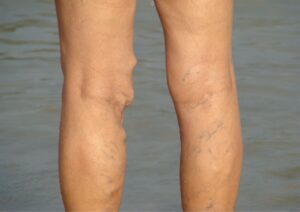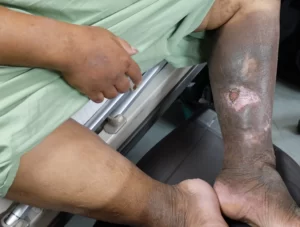Are you bothered by the prominent blue veins around your eyes? Periorbital veins, also known as eye veins, can be a cosmetic concern for many individuals. Understanding the causes, symptoms, and options for treating veins can help you find relief and improve your appearance.
Periorbital visible veins can become more visible due to several factors, including aging, thin skin, genetics, and lifestyle choices. Common symptoms may include dark circles and blue or purple veins that are more noticeable when tired or after crying. These veins can make you look older, tired, or even sad.
Fortunately, there are various options for treating veins available to help reduce the visibility of periorbital veins and improve your overall appearance. Non-invasive treatments such cosmetic procedures such as laser therapy and topical creams can be effective in minimising the appearance of these veins. In more severe cases, surgical procedures like sclerotherapy or microphlebectomy may be considered.
If you’re tired of living with insightly veins under your eyes and want to regain your youthful appearance, it’s time to explore available options for treating veins. Consult with a qualified healthcare professional to determine the best course of action for your specific needs.

What Causes Prominent Visible Veins Under the Eyes?
Eye veins can become more visible due to several factors. One of the main causes of visible veins is aging. As we age, the skin around our eyes becomes thinner, making the veins more visible. Additionally, the loss of collagen and elasticity in the skin can contribute to the appearance of periorbital veins.
Genetics also play a role in the development of periorbital veins ( eye veins). Some people have a genetic predisposition to thin and delicate skin, which can make the so called periorbital veins even more prominent. If your parents or close relatives have visible periorbital veins, there is a higher chance that you may develop them as well.
Lifestyle choices can also contribute to the visibility of periorbital veins. Factors such as excessive sun exposure, smoking, and alcohol consumption can weaken the skin and blood vessels, making the veins more noticeable. It’s important to protect your skin from the sun’s harmful rays and adopt a healthy lifestyle to minimize the appearance of periorbital veins.
Symptoms of periorbital veins
The most common symptom of periorbital veins( eye veins) is the appearance of dark blue or purple veins around the eyes. These veins may be more noticeable when you are tired or after crying. They can give the impression of tiredness, aging, or even sadness. Some individuals may also experience discomfort or aching around the eye area.
It’s important to note that periorbital veins are usually harmless and not a cause for medical concern. However, if you experience any severe pain, swelling, or changes in vision, it’s best to consult with a healthcare professional to rule out any underlying conditions.
Risk factors for periorbital veins
While anyone can develop periorbital veins, certain factors increase the risk of their visibility. As mentioned earlier, genetics play a significant role. If you have a family history of periorbital veins, you are more likely to develop them yourself.
Age is another risk factor. As we age, our skin naturally becomes thinner and loses elasticity, making the veins more prominent. Additionally, hormonal changes during pregnancy can also contribute to the appearance of periorbital veins.
Other risk factors include excessive sun exposure, smoking, and alcohol consumption. These lifestyle choices can weaken the skin and blood vessels, making the veins more noticeable.
Diagnosis of periorbital veins
If you are concerned about the appearance of periorbital veins, it’s best to consult with a qualified healthcare professional. They will perform a physical examination and ask about your medical history and any symptoms you may be experiencing.
In some cases, the healthcare professional may order additional tests to rule out underlying conditions. These tests may include ultrasound or venography to evaluate the blood flow and determine the extent of the vein visibility.
Why are periorbital veins difficult to treat?
Periorbital veins, located around the eyes, are difficult to treat due to their thin and delicate skin, proximity to fragile eye structures, risk of bruising and hematoma formation, limited treatment options, potential visual disturbances, and recurrence of veins.
Traditional treatments like sclerotherapy may not be suitable for these veins as in very rare occsion it has been responsible for cases of blindness. Additionally, periorbital veins may be more prone to recurrence due to the intricate network of blood vessels in the area.
Treatment options for periorbital veins
Fortunately, there are various treatment options available to help reduce the visibility of periorbital veins and improve your overall appearance. The choice of treatment depends on the severity of the veins and your individual needs.
Non-invasive Treatments for Periorbital Veins
Non-invasive treatments are often the first line of treatment for periorbital veins. These treatments are usually painless and have minimal downtime. One common non-invasive treatment option is laser therapy. Laser treatment targets the veins with a specific wavelength of light, causing them to fade over time. Multiple sessions may be required to achieve the desired results.
Another non-invasive option is the use of topical creams or ointments. These creams contain ingredients that help strengthen the blood vessels and reduce their visibility. However, it’s important to note that these creams may not provide permanent results and need to be used regularly to maintain the effect.
Surgical Treatments for Periorbital Veins
In more severe cases, surgical procedures may be considered to treat periorbital veins. Sclerotherapy is a common surgical treatment that involves injecting a solution into the veins to cause them to collapse and fade away. Microphlebectomy is another surgical option where small incisions are made to remove the veins.
It’s important to consult with a qualified healthcare professional to determine the most suitable surgical treatment option for your specific needs. They will assess the severity of the veins and discuss the potential risks and benefits of each procedure.
Prevention and Lifestyle Changes for Periorbital Veins
While it may not be possible to completely prevent the development of periorbital veins, there are steps you can take to minimize their visibility and prevent further progression.
Protecting your skin from excessive sun exposure is crucial. Use sunscreen with a high SPF, wear sunglasses, and avoid prolonged exposure to the sun, especially during peak hours. Quitting smoking and reducing alcohol consumption can also improve the health of your skin and blood vessels.
Maintaining a healthy lifestyle, including a balanced diet and regular exercise, can support overall skin health and minimize the appearance of periorbital veins beneath the eyes. It’s also beneficial to avoid rubbing or pulling on the delicate skin around the eyes, as this can contribute to the visibility of the veins.
In conclusion, periorbital veins can be a cosmetic concern for many individuals. Understanding the causes, symptoms, and treatment options is essential for finding relief and improving your appearance. Whether you opt for non-invasive treatments or surgical procedures, consulting with a qualified healthcare professional is crucial to determine the best course of action for your specific needs. By taking preventive measures and adopting a healthy lifestyle, you can minimize the visibility of periorbital veins and maintain a refreshed and rejuvenated look.
Non-invasive treatments for periorbital veins
Yes, non-invasive treatments like sclerotherapy and laser therapy can also be effective for treating periorbital veins. Here’s an overview of such treatments and how they work:
1. Sclerotherapy:
– Procedure: Sclerotherapy is a common non-invasive treatment for small to medium-sized veins, including periorbital veins. During the procedure, a solution (sclerosant) is injected directly into the affected veins using a very fine needle.
– Mechanism: The sclerosant irritates the vein lining, causing it to collapse and stick together. Over time, the body absorbs the treated vein, and blood flow is redirected to healthier, veins underneath.
– Effectiveness: Sclerotherapy is effective for smaller veins, and multiple sessions may be needed for optimal results.
– Recovery: There is minimal downtime after sclerotherapy. Patients are usually able to resume normal activities shortly after the procedure.
2. Laser Therapy (Laser Vein Removal):
– Procedure: Laser therapy involves the use of a focused beam of light to target the pigment in the blood vessels. This generates heat, which damages the vein and causes it to close off.
– Mechanism: The heat from the light energy the laser effectively seals the vein, leading to its eventual disappearance.
– Effectiveness: Laser therapy can be very effective for smaller veins, including periorbital veins. It is a precise treatment that doesn’t damage surrounding tissue.
– Recovery: Recovery time after laser therapy is minimal, and patients can usually resume normal activities immediately.
Surgical treatments for periorbital veins
Periorbital veins, also known as spider veins or broken capillaries, can be a cosmetic concern. Phlebectomy is a medical procedure that removes veins, typically on the skin’s surface, typically for varicose veins. It is a minimally invasive procedure, usually done outpatiently, and can lead to cosmetic improvement, reduced discomfort, quick recovery, and low risk of complications.
Prevention and lifestyle changes for periorbital veins
Non-invasive treatments are often the first line of defense against periorbital veins. These treatments aim to minimize the appearance of the veins without the need for surgery. One popular non-invasive option is laser therapy. This treatment uses laser energy to target and break down the blood vessels, causing them to fade over time. Laser therapy is generally safe and effective, with minimal discomfort and downtime.
Another non-invasive option is the use of topical creams or gels. These products typically contain ingredients that help strengthen the blood vessels and reduce their visibility. They can be applied directly to the affected area and may need to be used consistently for optimal results. It’s important to choose a cream or gel that is specifically formulated for periorbital veins and consult with a healthcare professional before starting any new treatment.
Additionally, lifestyle changes can also play a role in reducing the appearance of periorbital veins. Practices such as protecting the delicate eye area from excessive sun exposure, maintaining a healthy diet, and getting enough sleep can contribute to overall skin health and minimize vein visibility.
Conclusion
In more severe cases, surgical treatments may be considered to address periorbital veins. These procedures are typically performed by a qualified healthcare professional and may require some downtime for recovery.
One common surgical option is sclerotherapy, which involves injecting a solution directly into the affected veins. This solution causes the veins to collapse and fade over time. Sclerotherapy is generally safe and effective, but it may require multiple sessions for optimal results.
Another surgical option is microphlebectomy, which involves making small incisions near the affected veins and removing them through these incisions. This procedure is typically performed under local anesthesia and may leave minimal scarring. Microphlebectomy is considered a more minimally invasive treatments option and is usually reserved for more severe cases.
It’s important to note that surgical treatments should only be pursued after a thorough evaluation by a qualified healthcare professional. They may not be suitable for everyone and should be considered as a last resort when other non-invasive options have been exhausted.










